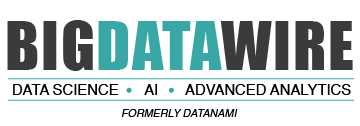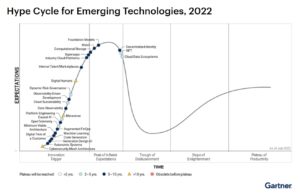
Data Observability, Metaverse Land on Gartner’s Hype Cycle for Emerging Tech

(Lightspring/Shutterstock)
The dog days of August are here, which can only mean one thing: It’s time for Gartner’s Hype Cycle for Emerging Technologies! The 2022 version includes numerous data and AI technologies among its 25 entries, including data observability and the metaverse. But which tech has the staying power to survive the hype?
Gartner produces many hype cycles–click here to read Jaime Hampton’s take on Gartner’s hype cycle for the integration platform as a service (iPaaS) market. But the hype cycle for emerging tech is unique because it distills the respected analyst group’s collective insight into more than 2,000 technologies it tracks into a set of two dozen “must-know” topics that have the potential to move the needle for early adopters over the next two to 10 years.
Gartner grouped its 2022 Hype Cycle around three themes that it sees playing outsize roles in today’s tech landscape. They include immersive experiences, AI automation, the optimizing how technologists deliver new tech.
Tech to watch in the immersive experiences category include metaverse, non-fungible tokens (NFTs), super apps and Web3, decentralized identity, digital humans, digital twin of the customer, and internal talent marketplaces. In AI automation, Gartner advises keeping an eye on tech like autonomic systems, causal AI, foundation models, generative design AI, and machine learning code generation.
Meanwhile, technologists will lean on a host of things to help them with the delivery of new digital products and services, including: computational storage, data observability, OpenTelemetry, observability driven development, cloud data ecosystems, cloud sustainability, cybersecurity mesh architecture, dynamic risk governance, industry cloud platforms, minimum viable architecture, platform engineering, and augmented FinOps.
“All technologies on this Hype Cycle are at an early stage,” Gartner Distinguished VP Analyst Gary Olliffe says in a press release, “but some are nascent and great uncertainty exists about how they will evolve. Such technologies present greater risks for deployment, but potentially greater benefits for early adopters who can assess and exploit them in line with their organization’s ability to handle unproven technologies.”
The metaverse, which refers to virtual reality and augmented reality (listed on emerging tech hype cycles of the past), is predominantly a consumer-oriented technology. However, because of its enormous potential, big tech firms are pounding their stakes into the ground now in hopes of being ready when the technology matures (still more than 10 years from now, per Gartner). The metaverse is also being spied as a potential new delivery vehicle for real-time analytic insights, and the potential around data collection is huge.
Data observability has been on the of hottest topics of the past two years, and is a topic that we’re expecting to keep making news in the second half of 2022. We also applaud Gartner including OpenTelemetry in its new hype cycle, as the technology has emerged as a standard that vendors of data and IT observability and application performance management (APM) tools can agree on.

Data observability is quickly becoming a must-have for organizations drowning in data (kurhan/Shutterstock)
Causal AI, meanwhile, is an emerging field that looks to take the AI field beyond the application of statistical probabilities and into modeling the actual cause and effect of phenomena. In the field of predicting human behavior, causal AI can help policymakers to avoid making “devastating…mistakes” wrought by the age-old error of confusing correlation with causation, researchers with the Surgo Foundation wrote in “The Case for Causal AI,” which was published two years ago in the Stanford Social Innovation Review.
Computational storage is an emerging tech that sees the addition of processors within the confines of the storage device. These computational storage devices (CSDs), such as the new SmartSSD that Samsung plans to ship later this year, can offload processing and acceleration from servers, thereby reducing the strain on CPUs and saving network bandwidth.
Gartner has also picked up on the recent activity around cloud data ecosystems, which is something we’re also tracking at Datanami. Industry giants like AWS and Snowflake have an early lead in the category, but new data marketplaces are popping up quickly, such as the one that Databricks launched less than two months ago.
Other tech included in the 2022 list, including things like observability-driven development–in which the state and behavior of system before, during, and after development is tracked–have the potential to help accelerate the development of better, more responsive, and more secure applications.
One thing that concerns us is that only three of the technologies listed on the 2021 Hype Cycle for Emerging Technologies returned in 2022. That makes it hard to gauge how Gartner is tracking the development of these emerging technologies over time (alas, we are not paying subsribers).
NFTs and Decentralized Identify, which were neck and neck in the 2021 Hype Cycle, are still tied at the hip, but they moved further off the Peak of Inflated Expectations and are headed directly toward the Trough of Disillusionment, with two to five years still before they climb out of the Slope of Enlightenment towards the holy Plateau of Productivity. Digital Humans, meanwhile, stayed about where it was in 2021: firmly planted on the climb to the Peak of Inflated Expectations following the Innovation Trigger, with a 10-plus year wait to reach the promised land.
Technologies that we wish were still included on the Hype Cycle include: quantum ML, homomorphic encryption, physics-informed AI, AI augmented design, active metadata management, and data fabric. We also wonder whatever happened to smart dust, which used to be a perennial contender in Gartner’s annual mid-summer compilation but has apparently been relegated to the dustbin of tech history.
Related Items:
Gartner Shuffles the Technology Deck with Latest ‘Hype Cycle’ Report (2021)
Gartner Gets Hyped for Emerging Tech (2020)
Gartner Sees AI Democratized in Latest ‘Hype Cycle’ (2018)
June 30, 2025
- Campfire Raises $35 Million Series A Led by Accel to Build the Next-Generation AI-Driven ERP
- Intel Xeon 6 Slashes Power Consumption for Nokia Core Network Customers
- Equal Opportunity Ventures Leads Investment in Manta AI to Redefine the Future of Data Science
- Tracer Protect for ChatGPT to Combat Rising Enterprise Brand Threats from AI Chatbots
June 27, 2025
- EarthDaily Ignites a New Era in Earth Observation with Landmark Satellite Launch
- Domo Deepens Collaboration with Snowflake to Accelerate AI-Driven Analytics and Data Integration on the AI Data Cloud
- AIwire Launches Annual People to Watch Program
June 26, 2025
- Thomson Reuters: Firms with AI Strategies Twice as Likely to See AI-driven Revenue Growth
- DataBahn Raises $17M Series A to Advance AI-Native Data Pipeline Platform
- BCG Report: Companies Must Go Beyond AI Adoption to Realize Its Full Potential
- H2O.ai Breaks New World Record for Most Accurate Agentic AI for Generalized Assistants
- Foresight Raises $5.5M Seed Round to Bring Unified Data and AI to the Private Market
- Treasure Data Launches MCP Server: Let Your LLM Talk to Your Data
- Fujitsu Strengthens Global Consulting with Focus on AI, Data, and Sustainability
- HPE Expands ProLiant Gen12 with New AMD Servers
- Emergence AI Launches CRAFT for Natural Language Data Workflow Automation
- Overture Maps Launches GERS, a Global Standard for Interoperable Geospatial IDs, to Drive Data Interoperability
June 25, 2025
- Inside the Chargeback System That Made Harvard’s Storage Sustainable
- What Are Reasoning Models and Why You Should Care
- Databricks Takes Top Spot in Gartner DSML Platform Report
- Snowflake Widens Analytics and AI Reach at Summit 25
- Why Snowflake Bought Crunchy Data
- Change to Apache Iceberg Could Streamline Queries, Open Data
- Agentic AI Orchestration Layer Should be Independent, Dataiku CEO Says
- Top-Down or Bottom-Up Data Model Design: Which is Best?
- LinkedIn Introduces Northguard, Its Replacement for Kafka
- The Evolution of Time-Series Models: AI Leading a New Forecasting Era
- More Features…
- Mathematica Helps Crack Zodiac Killer’s Code
- AI Agents To Drive Scientific Discovery Within a Year, Altman Predicts
- Solidigm Celebrates World’s Largest SSD with ‘122 Day’
- DuckLake Makes a Splash in the Lakehouse Stack – But Can It Break Through?
- ‘The Relational Model Always Wins,’ RelationalAI CEO Says
- Confluent Says ‘Au Revoir’ to Zookeeper with Launch of Confluent Platform 8.0
- Supabase’s $200M Raise Signals Big Ambitions
- The Top Five Data Labeling Firms According to Everest Group
- Data Prep Still Dominates Data Scientists’ Time, Survey Finds
- Toloka Expands Data Labeling Service
- More News In Brief…
- Astronomer Unveils New Capabilities in Astro to Streamline Enterprise Data Orchestration
- Astronomer Introduces Astro Observe to Provide Unified Full-Stack Data Orchestration and Observability
- BigID Reports Majority of Enterprises Lack AI Risk Visibility in 2025
- Databricks Unveils Databricks One: A New Way to Bring AI to Every Corner of the Business
- Snowflake Openflow Unlocks Full Data Interoperability, Accelerating Data Movement for AI Innovation
- Seagate Unveils IronWolf Pro 24TB Hard Drive for SMBs and Enterprises
- Gartner Predicts 40% of Generative AI Solutions Will Be Multimodal By 2027
- Databricks Donates Declarative Pipelines to Apache Spark Open Source Project
- Code.org, in Partnership with Amazon, Launches New AI Curriculum for Grades 8-12
- Zscaler Unveils Business Insights with Advanced Analytics for Smarter SaaS Spend and Resource Allocation
- More This Just In…



























